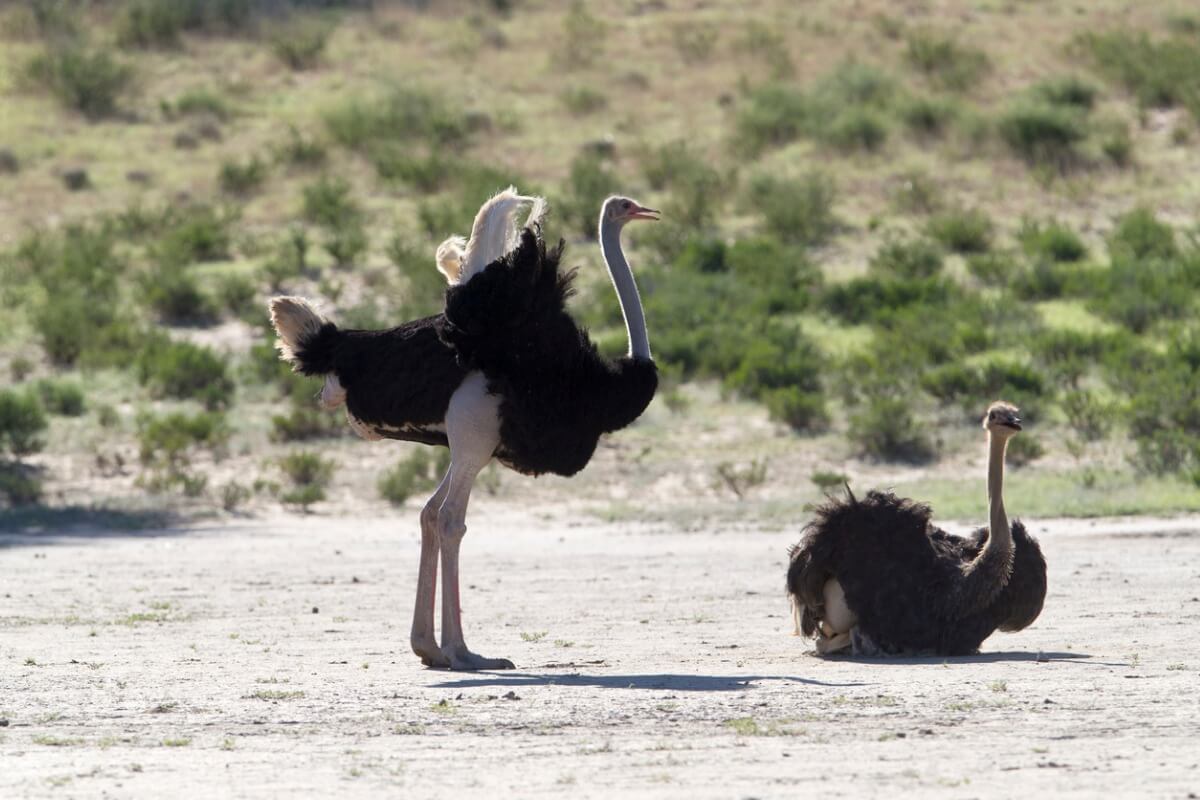Is it True that the Ostrich Buries its Head in the Ground?


Written and verified by the biologist Francisco Morata Carramolino
Animal behavior is a complex field of study where many mysteries remain unsolved. However, the question of whether the ostrich buries its head in the ground when scared is not one of them.
This is definitely a myth, albeit a persistent one. Not only is this behavior never observed in nature, but it also makes no biological sense. If ostriches followed this strategy, the predators wouldn’t miss the opportunity to devour them.
We invite you to continue reading these if you’d like to learn more about this myth and the real behavior that ostriches show against predators.
A myth that comes from ancient times
There’s no doubt that the idea that an ostrich buries its head in the ground is a myth. However, this is a very ancient belief, as some sources indicate that it can be traced back to Roman times.
Specifically, its origin could be found in the writings of Pliny the Elder, an important Roman writer and naturalist whose works have had great importance in history. Pliny was responsible for writing one of the first encyclopedias, called Naturalis Historia.
In this magnificent work, Pliny said that an ostrich buries its head in the ground, and, in doing so, believes that its entire body is hidden. Although this isn’t true, the myth has remained with us over time, as it has been integrated into our daily language and human beings have reproduced it in countless media.

Curiosities of the ostriches that could have originated this myth
These animals display certain behavior that, to some observers, could lead to confusion. In reality, ostriches don’t bury their heads in the ground, but they do have some very peculiar behavioral adaptations.
Ostriches build their nests by digging a shallow hole in the ground. Once the eggs are laid, they are frequently repositioned to ensure that they receive the proper conditions. They shake their heads at them, so it may appear that they’re burying them.
On the other hand, these animals search for food on the ground while standing. An ostrich’s head is very small, so it could also appear that they have buried it when they’re feeding.
Also, these birds ingest small stones from the ground. These mineral elements, which are called gastroliths, help to crush food in their digestive system, as these animals can’t chew. If you didn’t know this, then it could appear that the animal is burying its head.
Why doesn’t the ostrich bury its head in the ground when it feels threatened?
It’s clear that no ostrich puts its head in the ground when it’s afraid or wants to escape from predators. If you look closely at these animals in the wild, you won’t see this behavior.
Some physiological and evolutionary explanations can be given as to why this strategy doesn’t take place. If ostriches buried their heads in the ground, they would have difficulty breathing. Neither would they be able to see predators, which is usually quite helpful in avoiding them.
This is usually justified by saying that ostriches are so dim that they don’t even realize it. Although it’s true that their brain is very small compared to their body, intelligence doesn’t play a very important role in these aspects.
Instead, what’s really vital here is natural selection. This evolutionary mechanism indicates that organisms with traits better suited to their environment will be more likely to survive than the rest of the population. Therefore, they’ll have more offspring and these traits will become more prevalent in the population.
Ostriches that bury their heads in the ground would most likely be eaten by predators that are threatening them. Therefore, they would have no offspring and this strategy would quickly disappear.
Real strategies of ostriches against predators
As we’ve already said, the ostrich doesn’t bury its head in the ground. Instead, it has other very effective strategies to defend itself and avoid predation.
First of all, ostriches are incredibly fast. They can’t fly, but they reach speeds of up to 70 kilometers per hour. Therefore, one of the most effective strategies for these birds is to run away when they locate a predator.
Their powerful legs, along with their enormous size and pointed claws, offer these birds a second alternative defense. Faced with some threats, ostriches may choose to stand up and attack with very strong kicks.
When none of these defenses is feasible, these birds are also capable of hiding in vegetation. To do this, they lie completely on the ground, not only hiding their heads.
Lastly, these animals help each other. When in groups, ostriches alternate to keep an eye on their surroundings and feed. This makes it easier for the group to detect threats.

As has been proven, this preconception about ostriches is nothing more than a very popular myth. Although there’s nothing wrong with using it as a metaphor, you have to take into account animals’ real behavior, and not reduce them to preconceived ideas.
Animal behavior is a complex field of study where many mysteries remain unsolved. However, the question of whether the ostrich buries its head in the ground when scared is not one of them.
This is definitely a myth, albeit a persistent one. Not only is this behavior never observed in nature, but it also makes no biological sense. If ostriches followed this strategy, the predators wouldn’t miss the opportunity to devour them.
We invite you to continue reading these if you’d like to learn more about this myth and the real behavior that ostriches show against predators.
A myth that comes from ancient times
There’s no doubt that the idea that an ostrich buries its head in the ground is a myth. However, this is a very ancient belief, as some sources indicate that it can be traced back to Roman times.
Specifically, its origin could be found in the writings of Pliny the Elder, an important Roman writer and naturalist whose works have had great importance in history. Pliny was responsible for writing one of the first encyclopedias, called Naturalis Historia.
In this magnificent work, Pliny said that an ostrich buries its head in the ground, and, in doing so, believes that its entire body is hidden. Although this isn’t true, the myth has remained with us over time, as it has been integrated into our daily language and human beings have reproduced it in countless media.

Curiosities of the ostriches that could have originated this myth
These animals display certain behavior that, to some observers, could lead to confusion. In reality, ostriches don’t bury their heads in the ground, but they do have some very peculiar behavioral adaptations.
Ostriches build their nests by digging a shallow hole in the ground. Once the eggs are laid, they are frequently repositioned to ensure that they receive the proper conditions. They shake their heads at them, so it may appear that they’re burying them.
On the other hand, these animals search for food on the ground while standing. An ostrich’s head is very small, so it could also appear that they have buried it when they’re feeding.
Also, these birds ingest small stones from the ground. These mineral elements, which are called gastroliths, help to crush food in their digestive system, as these animals can’t chew. If you didn’t know this, then it could appear that the animal is burying its head.
Why doesn’t the ostrich bury its head in the ground when it feels threatened?
It’s clear that no ostrich puts its head in the ground when it’s afraid or wants to escape from predators. If you look closely at these animals in the wild, you won’t see this behavior.
Some physiological and evolutionary explanations can be given as to why this strategy doesn’t take place. If ostriches buried their heads in the ground, they would have difficulty breathing. Neither would they be able to see predators, which is usually quite helpful in avoiding them.
This is usually justified by saying that ostriches are so dim that they don’t even realize it. Although it’s true that their brain is very small compared to their body, intelligence doesn’t play a very important role in these aspects.
Instead, what’s really vital here is natural selection. This evolutionary mechanism indicates that organisms with traits better suited to their environment will be more likely to survive than the rest of the population. Therefore, they’ll have more offspring and these traits will become more prevalent in the population.
Ostriches that bury their heads in the ground would most likely be eaten by predators that are threatening them. Therefore, they would have no offspring and this strategy would quickly disappear.
Real strategies of ostriches against predators
As we’ve already said, the ostrich doesn’t bury its head in the ground. Instead, it has other very effective strategies to defend itself and avoid predation.
First of all, ostriches are incredibly fast. They can’t fly, but they reach speeds of up to 70 kilometers per hour. Therefore, one of the most effective strategies for these birds is to run away when they locate a predator.
Their powerful legs, along with their enormous size and pointed claws, offer these birds a second alternative defense. Faced with some threats, ostriches may choose to stand up and attack with very strong kicks.
When none of these defenses is feasible, these birds are also capable of hiding in vegetation. To do this, they lie completely on the ground, not only hiding their heads.
Lastly, these animals help each other. When in groups, ostriches alternate to keep an eye on their surroundings and feed. This makes it easier for the group to detect threats.

As has been proven, this preconception about ostriches is nothing more than a very popular myth. Although there’s nothing wrong with using it as a metaphor, you have to take into account animals’ real behavior, and not reduce them to preconceived ideas.
All cited sources were thoroughly reviewed by our team to ensure their quality, reliability, currency, and validity. The bibliography of this article was considered reliable and of academic or scientific accuracy.
- https://www.abc.net.au/science/articles/2006/11/02/1777947.htm
- https://safarisafricana.com/ostrich-head-in-sand/
- https://wildlifetv.wordpress.com/2014/10/07/why-do-people-think-that-ostriches-bury-their-heads-in-the-sand/
- Bertram, B. C. R. 1980. Vigilance and group size in ostriches. Animal Behaviour, 28: 278–286.
This text is provided for informational purposes only and does not replace consultation with a professional. If in doubt, consult your specialist.








